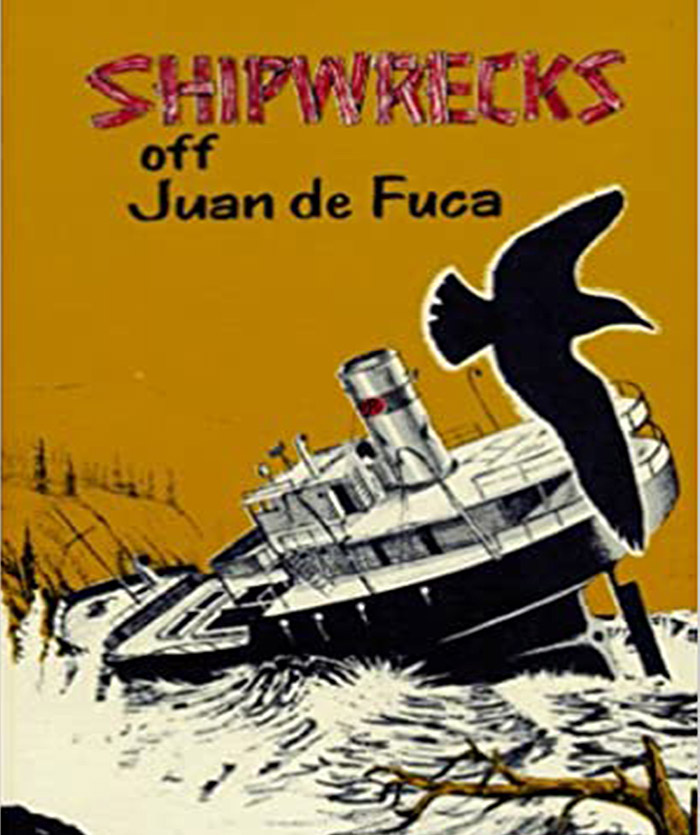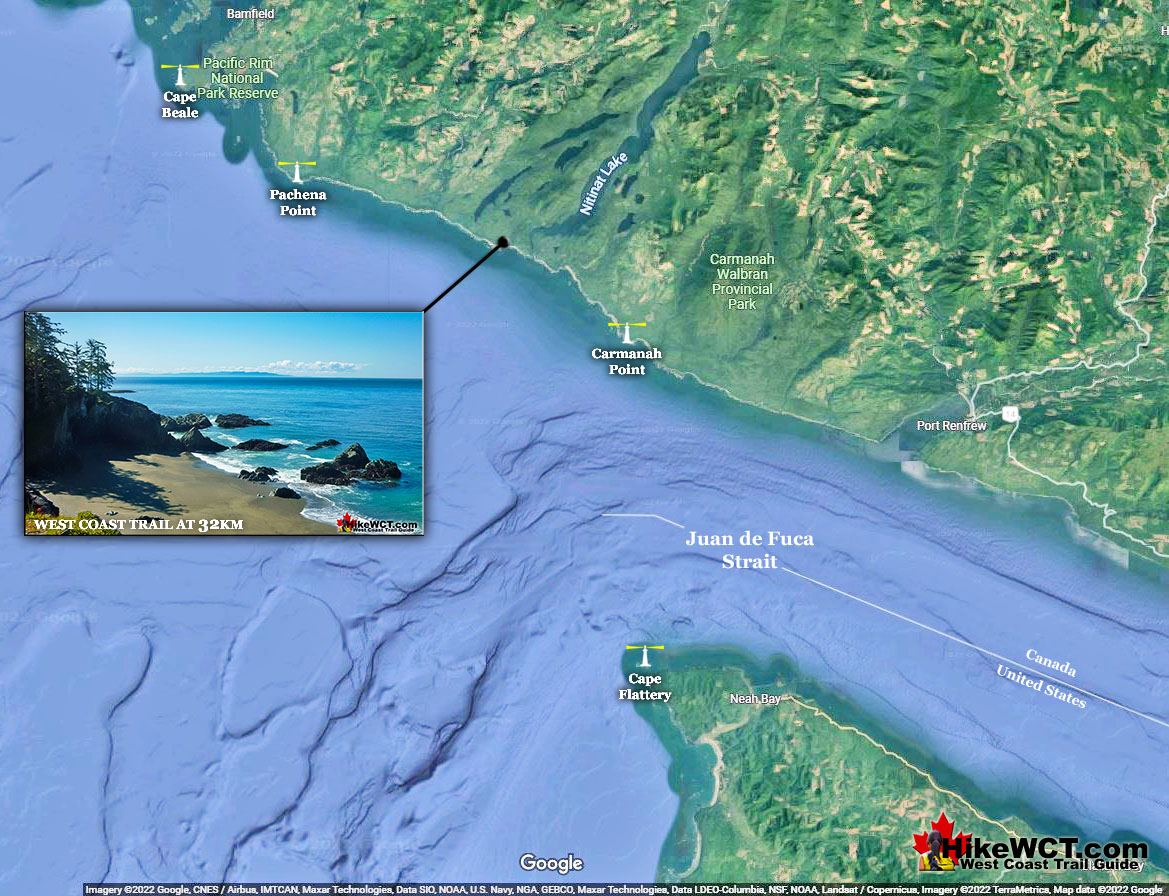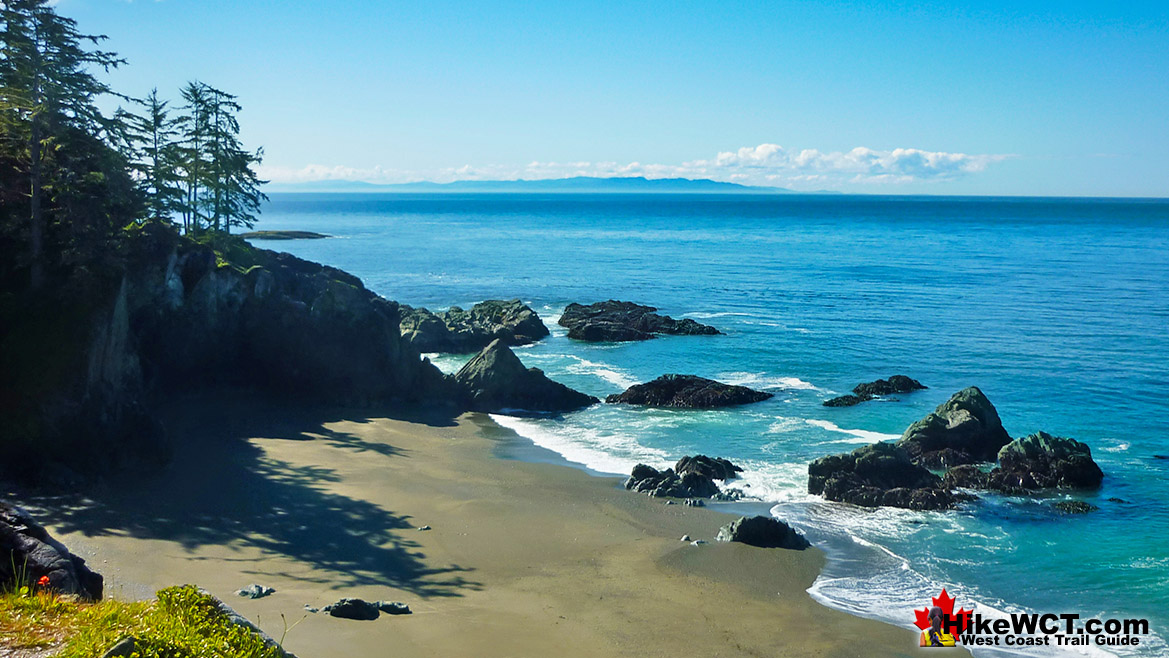![]() Shipwrecks Off Juan de Fuca by James A. Gibbs, published in 1968 is an amazing book about shipwrecks on both sides off Juan de Fuca Strait. What makes it such a great book is Gibbs lifetime of research on shipwrecks, his remarkable familiarity of the area and his tremendous ability to weave together the fascinating history of the area. He doesn’t just outline shipwrecks with a list of facts, but rather goes into details that bring the harrowing tales to life.
Shipwrecks Off Juan de Fuca by James A. Gibbs, published in 1968 is an amazing book about shipwrecks on both sides off Juan de Fuca Strait. What makes it such a great book is Gibbs lifetime of research on shipwrecks, his remarkable familiarity of the area and his tremendous ability to weave together the fascinating history of the area. He doesn’t just outline shipwrecks with a list of facts, but rather goes into details that bring the harrowing tales to life.
West Coast Trail Shipwrecks
![]() Alaskan at 4k
Alaskan at 4k ![]() Soquel at 5k
Soquel at 5k ![]() Sarah at 7k
Sarah at 7k ![]() Becherdass-Ambiadass at 8k
Becherdass-Ambiadass at 8k ![]() Michigan at 12k
Michigan at 12k ![]() Uzbekistan at 13.8k
Uzbekistan at 13.8k ![]() Varsity at 17.6k
Varsity at 17.6k ![]() Valencia at 18.3k
Valencia at 18.3k ![]() Janet Cowan at 19k
Janet Cowan at 19k ![]() Robert Lewers at 20k
Robert Lewers at 20k ![]() Woodside at 20.2k
Woodside at 20.2k ![]() Uncle John at 26.2k
Uncle John at 26.2k ![]() Vesta at 29k
Vesta at 29k ![]() Raita at 33k
Raita at 33k ![]() Skagit at 34.2k
Skagit at 34.2k ![]() Santa Rita at 37k
Santa Rita at 37k ![]() Dare at 39k
Dare at 39k ![]() Lizzie Marshall at 47k
Lizzie Marshall at 47k ![]() Puritan at 48.5k
Puritan at 48.5k ![]() Wempe Brothers at 49.4k
Wempe Brothers at 49.4k ![]() Duchess of Argyle at 58k
Duchess of Argyle at 58k ![]() John Marshall at 62.3k
John Marshall at 62.3k ![]() William Tell at 64.2
William Tell at 64.2 ![]() Revere at 69k
Revere at 69k ![]() Cyrus at 75k
Cyrus at 75k
West Coast Trail Campsites
![]() Pachena Bay Campground
Pachena Bay Campground ![]() Michigan Creek at 12k
Michigan Creek at 12k ![]() Darling River at 14k
Darling River at 14k ![]() Orange Juice Creek at 15k
Orange Juice Creek at 15k ![]() Tsocowis Creek at 16.5k
Tsocowis Creek at 16.5k ![]() Klanawa River at 23k
Klanawa River at 23k ![]() Tsusiat Falls at 25k
Tsusiat Falls at 25k ![]() Cribs Creek at 42k
Cribs Creek at 42k ![]() Carmanah Creek at 46k
Carmanah Creek at 46k ![]() Bonilla Creek at 48k
Bonilla Creek at 48k ![]() Walbran Creek at 53k
Walbran Creek at 53k ![]() Cullite Cove at 58k
Cullite Cove at 58k ![]() Camper Bay at 62k
Camper Bay at 62k ![]() Thrasher Cove at 70k
Thrasher Cove at 70k ![]() Pacheedaht Campground
Pacheedaht Campground
West Coast Trail shipwrecks in the book include the Valencia, the Uzbekistan, William Tell, Duchess of Argyle, Lizzie Marshall, Skagit, Santa Rita, Woodside, Sarah, Janet Cowan, Soquel and many more. What makes this book stand out is the interesting details he picks out of the scanty history of shipwrecks. He delves into the thrilling history of the Russian ship St. Nicholas in 1808, which shipwrecked leaving the crew in a battle of survival against a swarm of First Nations attackers. Gibbs talks about the brutality shipwreck survivors faced after surviving their initial ordeal. Countless shipwreck survivors in the 1800's and earlier that were lucky enough to survive and then found by First Nations people, usually faced two outcomes, murder or slavery. There is an unexpectedly simple reason for this terrifying and brutal welcome by the tribes of First Nations along the coast of Vancouver Island and the neighbouring coastlines north and south. The nature of the coastline, with its often hard to navigate terrain, irregular coastline, stormy seas, etc, meant that numerous tribes settled in small regions up and down the coast and fought each other with a brutality straight out of a horror movie. Raiding coastal villages was ongoing and capturing slaves and looting was the goal and torturing captives to death was commonplace. This brutal always at war mode of thinking explains the reflexive looting, enslaving and murdering that went on during the earliest known shipwrecks along the shores off Juan de Fuca Strait. If your tribe has been mercilessly attacked for centuries from the sea, you would inevitably perceive shipwreck survivors as unlucky attackers and would be enslavers.
One of the Best Books on West Coast Trail Shipwrecks
Shipwrecks Off Juan de Fuca by James A. Gibbs is possibly the best book on West Coast Trail shipwrecks as it is so well written and interesting as well as including most of the interesting shipwrecks passed by on the trail.
Shipwrecks Off Juan de Fuca Map
It is hard to talk about the history of shipwrecks along the West Coast Trail without talking about the United States side of Juan de Fuca Strait, which figures so prominently in almost every shipwreck in the Graveyard of the Pacific. Nearly all the shipwrecks were doomed once they passed Cape Flattery and failed to find the entrance of Juan de Fuca Strait, and instead were thrashed by stormy seas, blinded by fog and hurled into the jagged reefs along the West Coast Trail. For those of us that love the West Coast Trail and shipwreck history, Gibbs covers the exact part of the world that matters the most. The book even has a wonderful map illustration of the known shipwrecks off Juan de Fuca Strait, printed on the front and back inside flap.
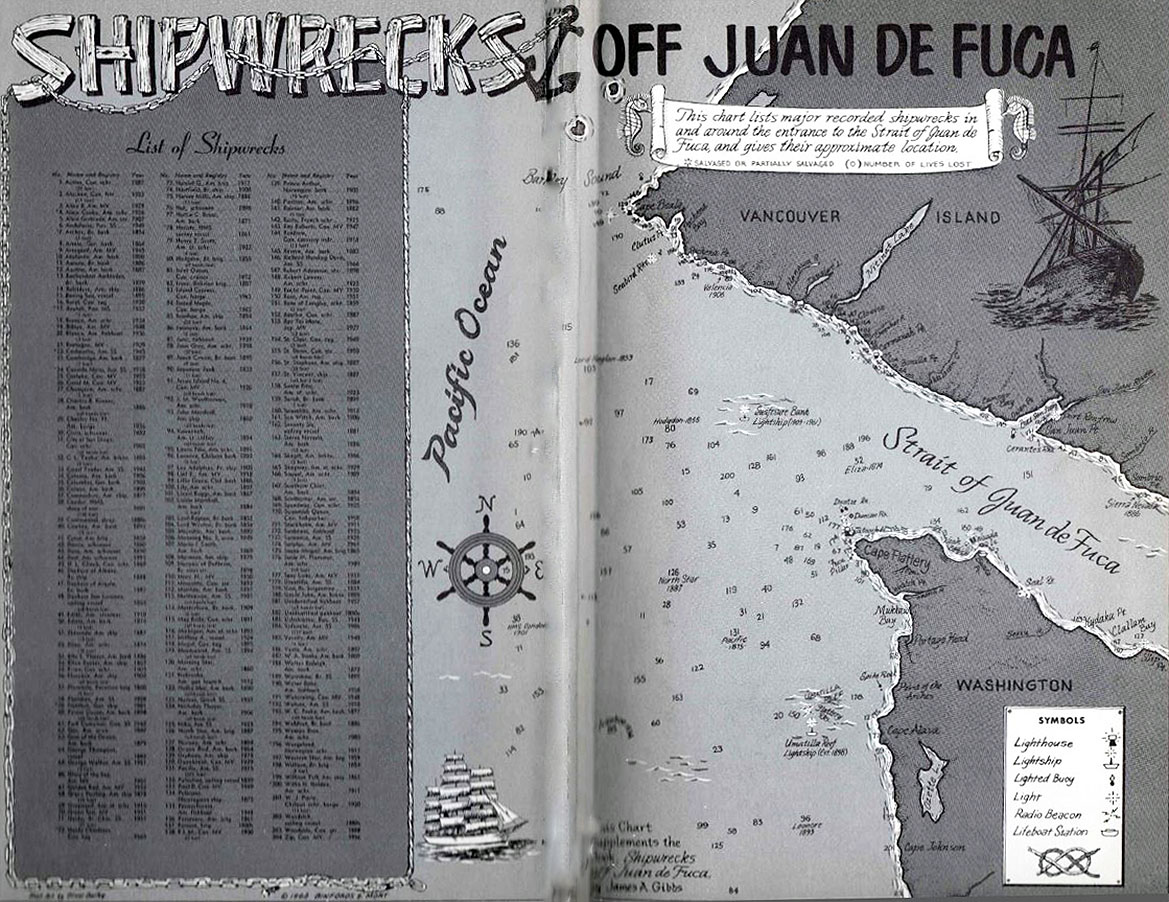
Cape Flattery and the West Coast Trail
Though the Cape Flattery Lighthouse lays well outside of the West Coast Trail it is almost always mentioned in shipwreck accounts that happened along Vancouver Island. Cape Flattery Lighthouse built in 1857 and the Carmanah Point Lighthouse built in 1891 on Vancouver Island mark the entrance to Juan de Fuca Strait. It is a testament to how treacherous Juan de Fuca Strait is by the fact that these two lighthouses proved insufficient to guide ships in safely. The Umatilla Lightship was added south of Cape Flattery in 1897 and the Swiftsure Lightship northwest of Cape Flattery in 1909. The Pachena Point Lighthouse was constructed in 1908 just 24 kilometers up the coast from Carmanah Point Lighthouse. Even with this concentration of lighthouses and lightships the brutal weather, changing currents and fog were still too overpowering to many ships and shipwrecks along the Graveyard of the Pacific continued for decades. The picture below is near the 32km marker of the West Coast Trail, just 12 kilometres west of the Carmanah Point Lighthouse which is at 44km. The view is looking across the mouth of Juan de Fuca Strait and the point of land in the distance is the United States and Cape Flattery is just beyond the tip.
As a testament to how good Shipwrecks Off Juan de Fuca by James A. Gibbs is, you can still find it everywhere online.
More Books About West Coast Trail Shipwrecks
West Coast Trail Shipwreck Books
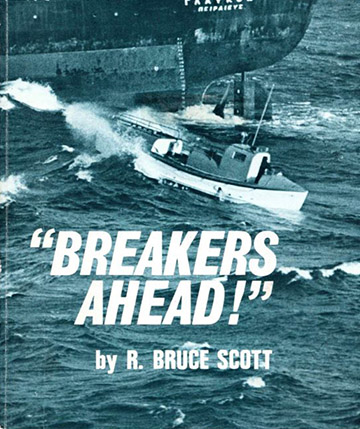

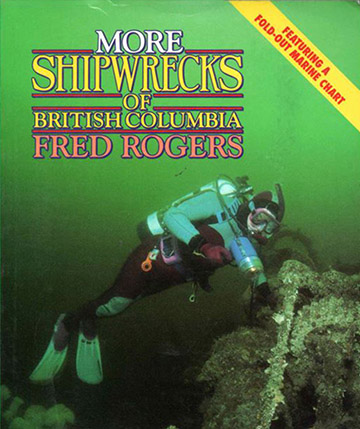

West Coast Trail A to Z
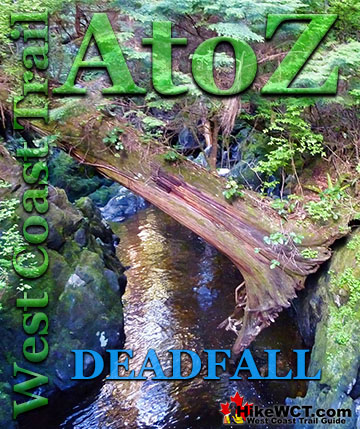

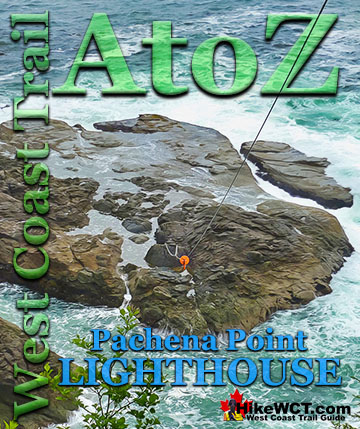
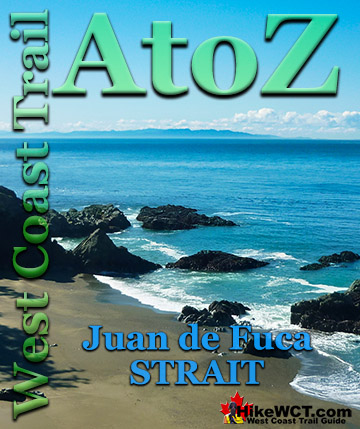
The West Coast Trail by Day
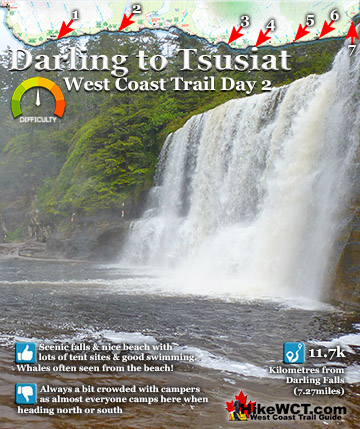
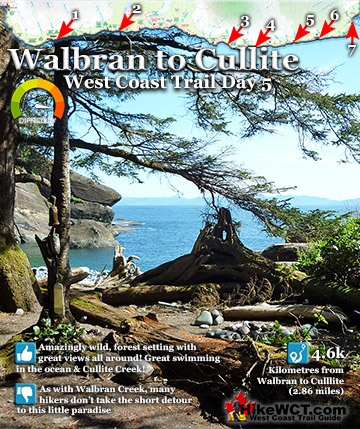
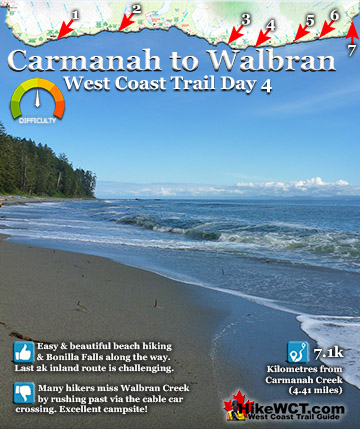
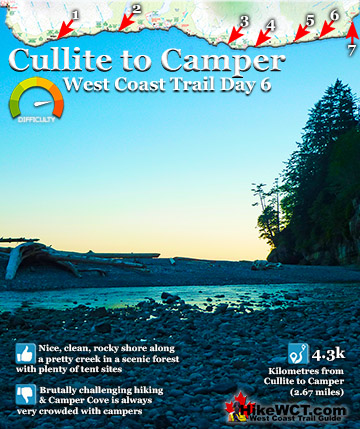
Explore BC Hiking Destinations!

The West Coast Trail
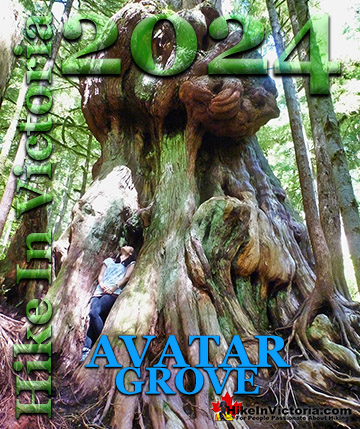
Victoria Hiking Trails

Clayoquot Hiking Trails
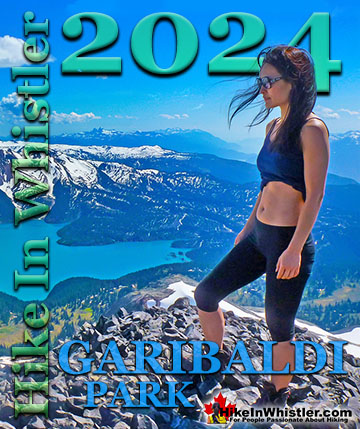
Whistler Hiking Trails
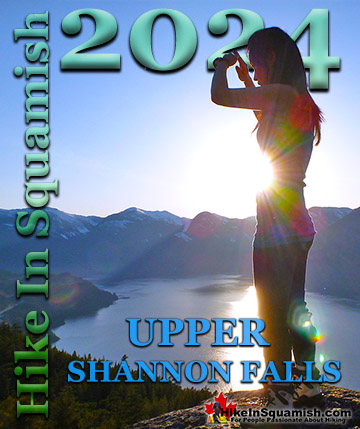
Squamish Hiking Trails

Vancouver Hiking Trails

